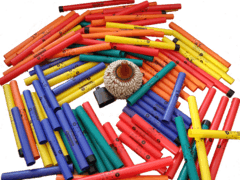Boomwhacker
A Boomwhacker is a lightweight, hollow, color-coded, plastic tube, tuned to a musical pitch by length. Boomwhackers are used as musical instruments in the percussion family. They were first produced by Craig Ramsell in 1995. His company, Whacky Music, has now sold more than 4 million units.[1]

History
Boomwhackers evolved at a time when junk bands and performers using instruments made from recycled materials were very popular. Among other methods, gas pipes or various cast-offs from plumbers were cut to length to produce different pitches when struck on an open end. Schools, meanwhile, created their own junk bands as a cheap way to simultaneously promote creativity and encourage recycling. However, creating a custom kit was labor-intensive, leaving a niche for Boomwhackers, which are premade and mass-produced.
Inventor
American Craig Ramsell reportedly came up with the idea for his Boomwhackers in 1994 while at home recovering from radiation therapy. While cutting cardboard tubes into shorter lengths for recycling he happened to notice the different pitches resulting from the different lengths and decided to investigate their creative potential. He experimented with various plastics before settling on plastic mailing tubes.[1] He and his partner, wife Monnie Ramsell, formed DrumSpirit as a sole proprietorship to market the tubes. The original plastic Boomwhackers were first produced in 1995. The current version, which is far more durable than the earlier prototype, was released in 1997.
Ramsell started Whacky Music, Inc. in 1998, marketing a wider variety of Boomwhacker sets and materials. Boomwhackers are now available to span 3½ chromatic octaves. (The addition of the Octavator Tube Caps in 1999 allowed for the third lower octave.)
In July, 2009 the Sedona, Arizona-based Whacky Music, Inc., sold its interests to Rhythm Band Instruments LLC of Fort Worth, Texas, through an asset purchase agreement. Boomwhackers are made in the USA and distributed internationally by Rhythm Band Instruments. Boomwhackers is a registered trademark owned by Rhythm Band Instruments, Fort Worth, TX.
Sound production
Boomwhackers produce musical tones when struck together, on the floor, or against nearly any surface. They can also be grouped together and struck with mallets in different configurations, in specialized holders (homemade or available from the manufacturer), similar to a horizontally-aligned xylophone.[2] When one end of a Boomwhackers tube is covered with what the manufacturer calls an Octavator Cap, the pitch it produces is lowered by an octave.
Usage
Boomwhackers are most commonly used in elementary music classrooms as an inexpensive alternative or supplement to traditional pitched instruments such as xylophones and metallophones.[3] Boomwhackers are often used by performance artists and other musical performance groups to add an element of spectacle.[4] They can also be used by people with intellectual and developmental impairment to develop sensorimotor skills, social skills, and creativity.[5]
References
- Greenberg, Steve (2008). Gadget Nation: A Journey Through the Eccentric World of Invention. Sterling. pp. 56–59.
- Anderson, William M; Joy E. Lawrence (2007). Integrating Music Into the Elementary Classroom. Cengage. p. 137.
- "Boomwhackers in Music Class". Teachers.net Gazette. January 2013. Archived from the original on May 16, 2017. Retrieved January 8, 2013.
- "Boomwhackers Colorful Music Tubes Instruments.West Music". United States[USA]. January 2020.
- Ramey, Maria (2011). Group Music Activities for Adults with Intellectual and Developmental Disabilities. Jessica Kingsley Publishers. p. 98.
- Martin J. Junker (2003): Tubular Music – Übungs- und Vortragsstücke für Boomwhacker-Ensemble. Fidula, Germany
External links
| Wikimedia Commons has media related to Boomwhackers. |